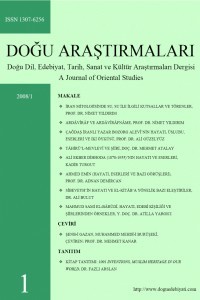AN ANALYSİS OF ' SECOND LİFE' İN ADONİS'S POEMS REGARDİNG FOUR SYMBOLS PHOENİX, HALLAJ, MAHYAR AND IMAM HOSSEİN GHADAR YAZDİ1 - DR FİROUZ HARİRCHİ
AN ANALYSİS OF ' SECOND LİFE' İN ADONİS'S POEMS REGARDİNG FOUR SYMBOLS PHOENİX, HALLAJ, MAHYAR AND IMAM HOSSEİN GHADAR YAZDİ1 - DR FİROUZ HARİRCHİ
The evident characteristic of symbol is its ambiguity, lack of precision and its being implicit and indirect. This means that in symbolic language, a concept higher and deeper than its appearance is taken into account. Adonis, a contemporary Arab poet, has often taken advantage of symbol in his poems and this is one of the mysteries of the complexity and ambiguity of his poems. There is no doubt that his poems are derived from his mystic, philosophical and social ideas and thoughts. In Adonis's poems, symbolic language has a deep relationship with myths. Therefore, his symbols are different from other contemporary poets whose symbols are based on political and social aspects. His poems, besides having political themes, demonstrate the dominant increasing strangulation in the Arab world. Through a comprehensive analysis of Adonis's poems and a deep study of his poetic symbols, a pervasive concept is understood which indicates that his poetry is decorated with a special thought which is belief in a second life. Of course, this 'second life' does not mean belief in resurrection. Rather, it reflects a social and mythological and sometimes philosophical concept. Restatement of symbols such as 'Phoenix, Hallaj, Mahyar and Imam Hossein' which reflect a kind of second life indicates Adonis's great interest in such a concept
